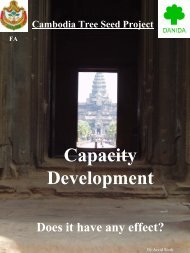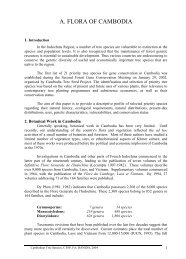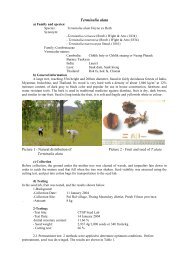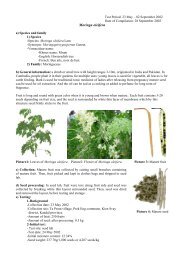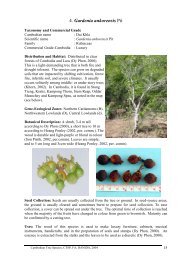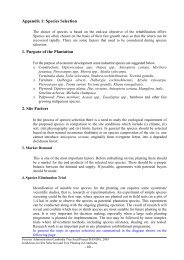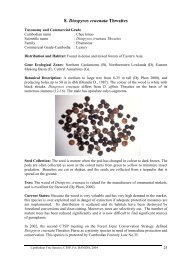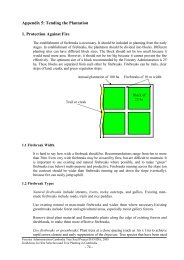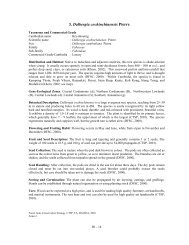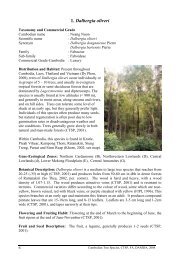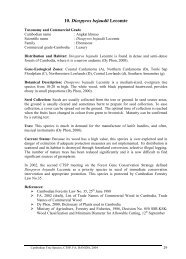Cambodia Forest Gene Conservation Case Study Part II
Cambodia Forest Gene Conservation Case Study Part II
Cambodia Forest Gene Conservation Case Study Part II
Create successful ePaper yourself
Turn your PDF publications into a flip-book with our unique Google optimized e-Paper software.
The impact may be summarised as follows:<br />
⇒ core staff and 50-75 other selected field staff equipped with significant technical skills and<br />
knowledge, and in addition, some significant attitudinal changes in favour of participatory<br />
approaches and initiatives coupled with an ability to obtain further knowledge.<br />
⇒ a far reach for awareness of the importance and the value of indigenous tree species and the<br />
importance of conserving their populations before they become too eroded.<br />
⇒ a far reach for technical knowledge to all levels of the <strong>Forest</strong>ry Administration, community<br />
members, NGOs, the armed forces and the private sector.<br />
⇒ upgraded teaching skills and knowledge at the Royal University of Phnom Penh, Royal<br />
University of Agriculture and Preak Leap National School of Agriculture, for lectures ensuring<br />
that knowledge of forest gene conservation is obtained by all graduates.<br />
The massive training offered has enabled staff of the <strong>Forest</strong>ry Administration<br />
and other key stakeholders to progress within respective fields more openly and<br />
much more confidently.<br />
7. Institutionalisation of <strong>Forest</strong> <strong>Gene</strong> <strong>Conservation</strong> Activities<br />
CTSP will terminate at the end of June 2006, and to ensure sustainability and continuation of its<br />
activities in general, and the forest gene resource conservation activities in particular,<br />
institutionalisation at the central level of the <strong>Forest</strong>ry Administration, as well as field level, is<br />
needed.<br />
7.1 Central Level<br />
Most FA staff members working in CTSP, including the daily manager, are assigned from the<br />
<strong>Forest</strong> and Wildlife Science Research Institute (FWSRI) within FA, (see Figure 5 on page 23).<br />
When CTSP terminates these key staff members will return to this institute. From an<br />
institutionalisation and sustainability point of view this is important, and it is equally important that<br />
all the equipment from the small CTSP seed laboratory will follow the staff and the same goes for<br />
computers, library, registers, all published material, etc. The home page, www.treeseedfa.org,<br />
should be kept open and updated. These in themselves will not necessarily ensure sufficient<br />
financial means to continue CTSP activities at the present level, but will ensure that the very well<br />
developed knowledge base related to use and conservation of forest genetic resources is kept as a<br />
unit/group within FA. The group will be nested in the FWSRI.<br />
22



